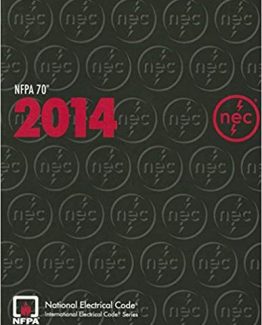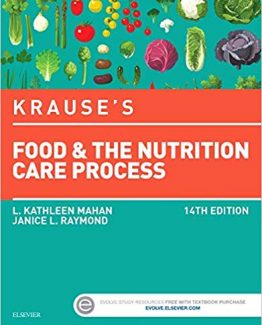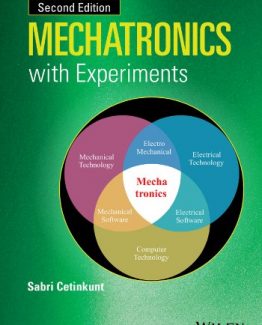Sustainable Energy 2nd Edition by Richard A. Dunlap, ISBN-13: 978-1337551663
[PDF eBook eTextbook] – Available Instantly
- Publisher: Cengage Learning; 2nd edition (January 1, 2018)
- Language: English
- 736 pages
- ISBN-10: 133755166X
- ISBN-13: 978-1337551663
Readers explore present and future energy needs as well as options for continued use of fossil fuels and alternative energy sources with Dunlap’s SUSTAINABLE ENERGY, 2nd Edition. Individual chapters thoroughly investigate each energy approach as the book covers both current energy production and future strategies. The author assumes reader familiarity with the basic concepts of freshman-level physics and chemistry. The text emphasizes the complexity of energy issues and the need for a multidisciplinary approach to solving energy problems. Quantitative end-of-chapter problems emphasize analyzing information, correlating data from various sources, and interpreting graphical data and interpolate values. Readers see real problems in producing and using energy as they realize that while exact calculations are important, a broad-based analysis is often most appropriate.
Table of Contents:
Contents
Preface
About the Author
Part I: Background
Chapter 1: Energy Basics
1.1 Introduction
1.2 Work, Energy, and Power
1.3 Forms of Energy
1.4 Some Basic Thermodynamics
1.5 Heat Engines and Heat Pumps
1.6 Electricity Generation
1.7 Summary
Problems
Bibliography
Chapter 2: Past, Present, and Future World Energy Use
2.1 Introduction
2.2 Past and Present Energy Use
2.3 Exponential Growth
2.4 The Hubbert Modelof Resource Utilization
2.5 Challenges for Sustainable Energy Development
2.6 Summary
Problems
Bibliography
Part II: Fossil Fuels
Chapter 3: Fossil Fuel Resources and Use
3.1 Introduction
3.2 Oil
3.3 Refining
3.4 Natural Gas
3.5 Coal
3.6 Overview of Fossil Fuel Resources
3.7 Enhanced Oil Recovery
3.8 Oil Shale
3.9 Extra-Heavy Oil and Tar Sands
3.10 Coal Liquefaction and Gasification
3.11 Summary
Problems
Bibliography
Chapter 4: Environmental Consequences of Fossil Fuel Use
4.1 Introduction
4.2 Thermal Pollution
4.3 Chemical and Particulate Matter Pollution
4.4 The Greenhouse Effect
4.5 Climate Change
4.6 Carbon Sequestration
4.7 International Climate Change Initiatives
4.8 Summary
Problems
Bibliography
Part III: Nuclear Energy
Chapter 5: Some Basic Nuclear Physics
5.1 Introduction
5.2 The Structure of the Nucleus
5.3 Binding Energy
5.4 Nuclear Decays
5.5 Nuclear Reactions
5.6 Summary
Problems
Bibliography
Chapter 6: Energy from Nuclear Fission
6.1 Introduction
6.2 The Fission of Uranium
6.3 Nuclear Reactor Design
6.4 Fission Reactor Control
6.5 Types of Thermal Neutron Reactors
6.6 Current Use of Fission Energy
6.7 Uranium Resources
6.8 Nuclear Safety
6.9 Risk Assessment
6.10 Waste Disposal
6.11 Advanced Reactor Design
6.12 Fast Breeder Reactors
6.13 Summary
Problems
Bibliography
Chapter 7: Energy from Nuclear Fusion
7.1 Introduction
7.2 Fusion Energy
7.3 Magnetic Confinement Reactors
7.4 Inertial Confinement Reactors
7.5 Progress toward a Fusion Reactor
7.6 Summary
Problems
Bibliography
Part IV: Renewable Energy
Chapter 8: Direct Use of Solar Energy
8.1 Introduction
8.2 Properties of Sunlight
8.3 Heat Transfer
8.4 Solar Collector Design
8.5 Residential Heating Needs
8.6 Heat Storage
8.7 Passive Solar Heating
8.8 Transpired Solar Collectors
8.9 Summary
Problems
Bibliography
Chapter 9: Electricity from Solar Energy
9.1 Introduction
9.2 Solar Electric Generation
9.3 Photovoltaic Devices
9.4 Application of Photovoltaic Devices
9.5 Global Use of Photovoltaics
9.6 Summary
Problems
Bibliography
Chapter 10: Wind Energy
10.1 Introduction
10.2 Wind Turbine Design
10.3 Obtaining Energy from the Wind
10.4 Applications of Wind Power
10.5 Summary
Problems
Bibliography
Chapter 11: Hydroelectric Energy
11.1 Introduction
11.2 Energy from Water
11.3 Turbine Design
11.4 High Head Systems
11.5 Low Head and Run-of-the-River Systems
11.6 Utilization of Hydroelectric Power
11.7 Environmental Consequences of Hydroelectric Energy
11.8 Summary
Problems
Bibliography
Chapter 12: Wave Energy
12.1 Introduction
12.2 Energy from Waves
12.3 Wave Power Devices
12.4 Wave Energy Resources
12.5 Summary
Problems
Bibliography
Chapter 13: Tidal Energy
13.1 Introduction
13.2 Energy from the Tides
13.3 Barrage Systems
13.4 Nonbarrage Tidal Power Systems
13.5 Summary
Problems
Bibliography
Chapter 14: Ocean Thermal Energy Conversion and Ocean Salinity Gradient Energy
14.1 Introduction
14.2 Basic Principles of Ocean Thermal Energy Conversion
14.3 OTEC System Design
14.4 Physics of the Operation of an OTEC System
14.5 Implementation of OTEC Systems
14.6 Ocean Salinity Gradient Energy: Basic Principles
14.7 Applications of Ocean Salinity Gradient Energy
14.8 Summary
Problems
Bibliography
Chapter 15: Geothermal Energy
15.1 Introduction
15.2 Basics of Geothermal Energy
15.3 Direct Use of Geothermal Energy
15.4 Geothermal Electricity
15.5 Utilization of Geothermal Resources and Environmental Consequences
15.6 Summary
Problems
Bibliography
Chapter 16: Biomass Energy
16.1 Introduction
16.2 Wood
16.3 Ethanol Production
16.4 Biodiesel
16.5 Biogas
16.6 Municipal Solid Waste
16.7 Summary
Problems
Bibliography
Part V: Energy Conservation, Energy Storage, and Transportation
Chapter 17: Energy Conservation
17.1 Introduction
17.2 Approaches to Energy Conservation
17.3 Cogeneration
17.4 Smart Grid
17.5 Energy Conservation in the Community – LED Streetlights
17.6 Home Heating and Cooling
17.7 Residential Lighting
17.8 Transportation
17.9 Summary
Problems
Bibliography
Chapter 18: Energy Storage
18.1 Introduction
18.2 Pumped Hydroelectric Power
18.3 Compressed Air Energy Storage
18.4 Flywheels
18.5 Superconducting Magnetic Energy Storage (SMES)
18.6 Summary
Problems
Bibliography
Chapter 19: Battery Electric Vehicles (BEVs)
19.1 Introduction
19.2 Battery Types
19.3 BEV Requirements and Design
19.4 History of BEVs
19.5 Supercapacitors
19.6 Summary
Problems
Bibliography
Chapter 20: Hydrogen
20.1 Introduction
20.2 Properties of Hydrogen
20.3 Hydrogen Production Methods
20.4 Storage and Transportation of Hydrogen
20.5 Hydrogen Internal Combustion Vehicles
20.6 Fuel Cells
20.7 Fuel Cell Vehicles
20.8 Hydrogen: Present and Future
20.9 Efficiency of Different Transportation Technologies
20.10 Summary
Problems
Bibliography
Part VI: The Future
Chapter 21: Future Prospects and Research and Design Projects
21.1 Introduction
21.2 Approaches to Future Energy Production
21.3 Key Considerations
21.4 Overview of Future Energy Technologies
21.5 Efficient Energy Utilization
21.6 Conclusions
Bibliography
Appendices
Appendix I: Powers of Ten
Appendix II: Physical Constants
Appendix III: Energy Conversion Factors
Appendix IV: Miscellaneous Conversion Factors
Appendix V: Energy Content of Fuels
Appendix VI: R-values in Metric and British Units
Appendix VII: The Elements
Appendix VIII: Table of Acronyms
Index
Richard A. Dunlap is a research professor in the Department of Physics and Atmospheric Science at Dalhousie University. He received a B.S. in Physics from Worcester Polytechnic Institute (1974), an A.M. in Physics from Dartmouth College (1976) and a Ph.D. in Physics from Clark University (1981). Since 1981 he has been on the faculty at Dalhousie University. From 2001 to 2006 he was Killam Research Professor of Physics and from 2009 to 2015 he was Director of the Dalhousie University Institute for Research in Materials. Professor Dunlap is author of three previous textbooks: EXPERIMENTAL PHYSICS: MODERN METHODS (Oxford 1988), THE GOLDEN RATIO AND FIBONACCI NUMBERS (World Scientific 1997), and AN INTRODUCTION TO THE PHYSICS OF NUCLEI AND PARTICLES (Brooks/Cole 2004). Over the years his research interests have included critical phenomena, magnetic materials, amorphous materials, quasicrystals, hydrogen storage, superconductivity, and materials for advanced rechargeable batteries. He has published more than 300 refereed research papers.
What makes us different?
• Instant Download
• Always Competitive Pricing
• 100% Privacy
• FREE Sample Available
• 24-7 LIVE Customer Support






Reviews
There are no reviews yet.